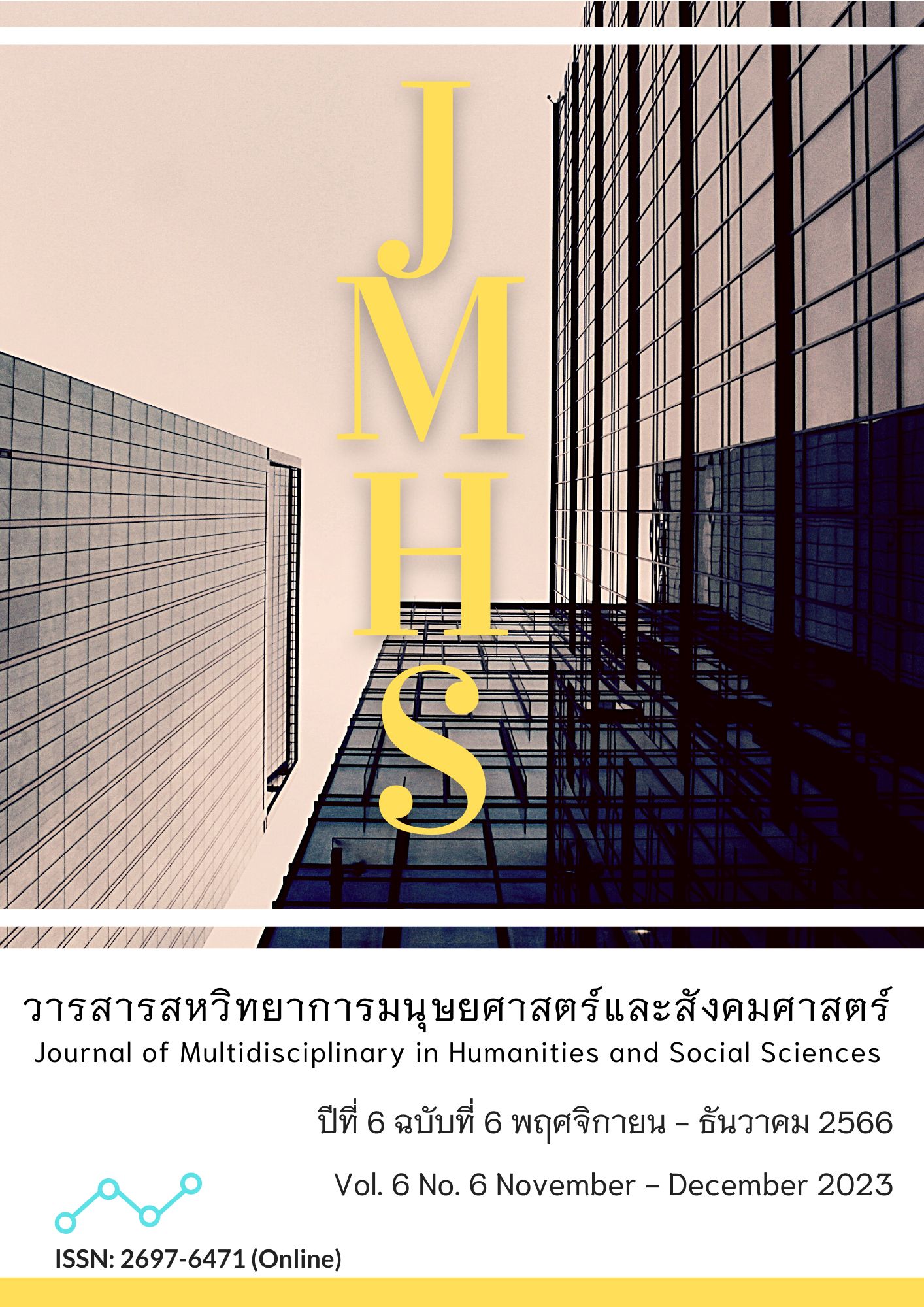Curriculum Development of Pre-Cane Orientation and Mobility Skill Using Taba Model for Students with Visual Impairments and Multiple Disabilities
Main Article Content
Abstract
This article aimed to study the development of pre-cane orientation and mobility skill curricula, with an efficiency test included. The eligible target group of five was purposefully selected with the following conditions: visually impaired and with multiple disabilities studied in a multi-graded classroom, Room 1 (kindergarten and grade 1), 6–13 years old, in a school dedicated to disabilities in Chiang Mai. The research tools at phase 1 were: 1) personal learner data checklist; 2) teacher interview forms to develop curriculum; and 3) post-test and use the data to find efficiency using the calculation formula E1/E2, set the 70/70 efficiency criterion by the scores of exercises and post-test. Data were analyzed with frequency, percentage, and average percentage.
The research results were found as follows: the development of a pre-cane orientation and mobility skill curriculum for students with multiple disabilities and visual impairments according to the Taba model was subject-mater course components with a complete and 80-hour time structure. The efficiency scores were 88.50/74.00, which were higher than the criterion. Knowledge of this research, the curriculum is appropriate for students with special needs and multiple disabilities. Students can apply it in their daily lives. Encourage students to be able to move themselves to different places. freely and safely.
Article Details

This work is licensed under a Creative Commons Attribution-NonCommercial-NoDerivatives 4.0 International License.
Views and opinions appearing in the Journal it is the responsibility of the author of the article, and does not constitute the view and responsibility of the editorial team.
References
กระทรวงศึกษาธิการ. (2555). นโยบายปฏิรูปการศึกษาสำหรับคนพิการในทศวรรษที่ 2 (พ.ศ. 2552-2561). กรุงเทพฯ: สำนักพิมพ์พุทธศาสนาแห่งชาติ.
กฤตมันต์ วัฒนาณรงค์. (2557). นวัตกรรมและเทคโนโลยีเทคนิคศึกษา. (พิมพ์ครั้งที่ 3). กรุงเทพฯ: ศูนย์ผลิตตำราเรียน, มหาวิทยาลัยเทคโนโลยีพระจอมเกล้าพระนครเหนือ.
เชวง ดุริยางคเศรษฐ์. (2555). การพัฒนาเทคนิคเพื่อฝึกทักษะการใช้ไม้เท้าสำหรับนักเรียนที่มีความบกพร่องทางการเห็น.(วิทยานิพนธ์ปริญญามหาบัณฑิต). มหาวิทยาลัยเทคโนโลยีพระจอมเกล้าพระนครเหนือ.
ประกาศกระทรวงศึกษาธิการ. เรื่อง กำหนดประเภทและหลักเกณฑ์ของคนพิการทางการศึกษา 2552. (2552, 8 มิถุนายน). ราชกิจจานุเบกษา, เล่ม 126 ตอนพิเศษ 80 ง, หน้า 47.
ปัณณ์พัฒน์ จันทร์สว่าง. (2560). บุคคลพิการซ้อน (Children with Multiple Disabilities). สืบค้นเมื่อ 8 มิถุนายน 2563, จาก http://taamkru.com/บุคคลพิการซ้อน
พระราชบัญญัติการจัดการศึกษาสำหรับคนพิการ พ.ศ. 2551 และที่แก้ไขเพิ่มเติม (ฉบับที่ 2) พ.ศ. 2556. (2556, 17 พฤษภาคม). ราชกิจจานุเบกษา. เล่ม 130 ตอนที่ 42 ก, หน้า 4-5.
พิกุล เลียวสิริพงศ์. (ม.ป.ป.). การปรับหลักสูตร. เอกสารประกอบการเรียน กระบวนวิชา 070306. เชียงใหม่: คณะศึกษาศาสตร์ มหาวิทยาลัยเชียงใหม่.
พีรศักดิ์ ชัยรุ่งโรจน์ปัญญา. (2551). การพัฒนาหลักสูตรการซ่อมคอมพิวเตอร์เบื้องต้นสำหรับนักเรียนที่มีความบกพร่องทางการได้ยินโรงเรียนโสตศึกษาอนุสารสุนทร จังหวัดเชียงใหม่(วิทยานิพนธ์ปริญญามหาบัณฑิต). มหาวิทยาลัยเชียงใหม่.
มารุต พัฒผล. (2562). แนวคิดหลักการพัฒนาหลักสูตร. กรุงเทพฯ: ศูนย์ผู้นำนวัตกรรมหลักสูตรและการเรียนรู้.
เมธาพร ยะดอนใจ. (2556). การจัดกิจกรรมการเคลื่อนไหวร่วมกับการใช้ประสาทการรับรู้เพื่อส่งเสริมทักษะ กล้ามเนื้อมัดใหญ่ของเด็กพิการซ้อนอายุ 3-5 ปี. Journal of Multidisciplinary in Social Sciences, 9(1), 207-222. Retrieved from https://so03.tci-thaijo.org/index.php/sduhs/article/view/29336
รัฐธรรมนูญแห่งราชอาณาจักรไทย พ.ศ. 2560. (2560, 6 เมษายน). ราชกิจจานุเบกษา. เล่ม 134 ตอนที่ 40 ก, หน้า 8.
ศันสนีย์ คำจันทา. (2556). การประเมินผลการดำเนินงานการจัดบริการฟื้นฟูสมรรถภาพคนตาบอด ด้านการทำความคุ้นเคยกับสภาพแวดล้อมและการเคลื่อนไหว: กรณีศึกษา โรงพยาบาลสรรพสิทธิประสงค์หรือศูนย์ให้บริการ O&M จังหวัดอุบลราชธานี(วิทยานิพนธ์ปริญญามหาบัณฑิต). มหาวิทยาลัยราชภัฏอุบลราชธานี.
Bloom, B. S. et al. (1956). A Taxonomy of Educational Objectives: Handbook I The Cognitive Domain. New York: Longman.
Dewey, J. (1963). Experience and Education. New York: Macmillan.
Skellenger A.C., & Sapp W.K. (2010). Teaching orientation and mobility for the early childhood years. In Wiener W. R., Welsh R. L., & Blasch B. B. (Eds.), Foundations of orientation and mobility: Volume II, instructional strategies and practical applications (3rd ed.), (pp. 163–207). New York: AFB Press.
Taba, H. (1962). Curriculum Development Theory and Practice. New York: Harcourt.
Tataka, W. (2018). Curriculum barriers to teaching orientation and mobility in selected schools for learners with visual impairments, West Pokot and Siaya Counties, Kenya(Master’s thesis). Kenyatta University.
Texas Education Agency. (2017). Guidelines and standards for educating students with visual impairments in Texas. Retrieved from http://www.tsbvi.edu/attachments/EducatingStudentswithVIGuidelinesStandards.pdf


